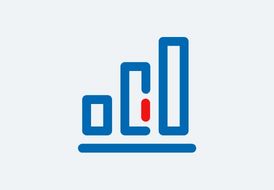Occupational safety and health management
To help combat the Covid-19 pandemic, we have set up our own vaccination centers and are also offering vaccinations through our occupational medical service. A total of 32,000 vaccinations have been carried out in ten DB vaccination centers and 35 other ias AG occupational medical service facilities. Following an EU-wide tender, the occupational medical service contract has been awarded to four service providers. The capacity and resource management of the occupational medical service providers is being digitalized as part of this realignment, thereby playing a part in the design of a modern occupational safety and health management framework. With the introduction of a sustainable IT platform that interlinks the occupational health and workplace safety services and hazardous substance management, a significant milestone in the implementation of the technology and digitalization strategy has been reached in these areas.
Our occupational health and safety policy is designed to continuously decrease the number and severity of accidents. The cross-functional cooperation has allowed us to implement Group-wide preventive measures quickly during the Covid-19 pandemic. In doing so, we have not only complied with legal requirements in consultation with works councils and DB management as well as the statutory accident insurance scheme for Federal agency and railway personnel (Unfallversicherung Bund und Bahn; UVB), but also set minimum requirements for protective measures throughout Germany, irrespective of the various government and autonomous health and safety regulations. Group-wide standards were agreed on social distancing, good hygiene practices, mask wearing and ventilation. These standards have been taken into account in risk assessments and communicated in occupational health and safety instructions.
In 2021, the planned adjustments were made to the framework guidelines on occupational health and safety. These related to the focus areas of risk assessment and accident management. Initial measures, such as a training program to supplement the annual occupational health and safety training, were also developed in the Group-wide Occupational Health and Safety Working Group to improve the quality of preventive health and safety in the Integrated Rail System in accordance with the zero-accident approach. The measures have been tested successfully, including in a pilot with several companies.
The joint zero-accident occupational health and safety strategy has, for the Integrated Rail System, the strategic objective of ensuring “no work accidents or work-related illnesses.” The top priority is to avoid fatal and serious occupational accidents and occupational diseases. If a fatal or serious occupational accident nevertheless occurs, we cooperate closely with the competent authorities and do everything possible to prevent similar causes of accidents in future. We are represented in the Zero Accident Forum of the German Statutory Accident Insurance’s Institute for Occupational Health and Safety (Institut für Arbeitsschutz der Deutschen Gesetzlichen Unfallversicherung; IFA). The forum is a network of companies that enables them to learn from one other so that they can reduce the number of accidents at work, including on the way to and from work, to zero.
| SICKNESS RATE BASED ON HOURS / % | 2021 | 2020 | 2019 | |
DB Long-Distance | 6.0 | 5.8 | 6.7 | |
DB Regional | 7.5 | 7.6 | 7.9 | |
DB Cargo | 6.7 | 6.4 | 7.1 | |
DB Netze Track | 4.9 | 5.0 | 5.6 | |
DB Netze Stations | 5.2 | 5.5 | 6.5 | |
DB Netze Energy | 3.3 | 3.4 | 4.2 | |
Other | 5.2 | 5.4 | 6.3 | |
DB Schenker | 5.4 | 8.1 | 6.7 | |
DB Group | 5.7 | 6.0 | 6.5 | |
Germany (companies with about 97% of domestic employees).
The sickness rate has fallen further, a possible indication that the extensive hygiene and safety measures taken in the context of the Covid-19 pandemic are having an effect.
| OCCUPATIONAL ACCIDENTS AND LTIF | 2021 | 2020 | 2019 | |
Fatal accidents 1) | 4 | 6 | 7 | |
thereof in Germany 2) | 4 | 2 | 5 | |
Lost time injury frequency (LTIF) 2), 3) | 21.8 | 21.5 | 25.0 | |
1) Worldwide (companies with about 98% of employees).
2) Germany (companies with about 98% of domestic employees).
3) Lost time injury frequency = LTIF (work accidents that cause the employee to be absent for longer than one calendar day) 1,000,000/working hours.
Compliance with internal standards and national laws serve to protect employees. A safe work environment and healthy employees contribute to success. Digital events and active communication measures on the topic of occupational health and safety were implemented to achieve the goal of raising awareness about safety and personal responsibility. We are continuously working to optimize safety. With lost time injury frequency (LTIF), we have established an indicator to aid us in further reducing the frequency of accidents.
The fatal workplace accidents in 2021 occurred in the infrastructure division in DB Netze Track and in DB Schenker. Fatal workplace accidents at DB Group are systematically investigated in the affected business units, and any possible process-related improvements and further measures are identified and implemented.
About 65 companies in Germany are included in the LTIF calculation. Close examination of the LTIF shows a differentiated picture, even in international comparison, as all areas of activity within DB Group are included in the calculation, rather than just sub-areas. Our goal within the scope of our occupational health and safety policy is to continuously and sustainably reduce the LTIF. Our zero-accident measures play a role in this. We involve the business and service units in the Group-wide Occupational Health and Safety Working Group, thereby promoting an overall culture of safety to ensure the safety of our employees. The LTIF in Germany is at the same level as in the previous year.
For 2022, we aim to continue development on the SAP EH&S IT application that has been introduced and drive forward new digital formats in the context of increased digitalization. We are working continuously to place greater emphasis on executives’ responsibility and their function as role models. We have therefore developed further learning opportunities for executives as part of the occupational health and safety strategy for the Integrated Rail System.
Occupational health and safety committees at DB Group
In Germany, companies (production facilities, branches, “Wahlbetriebe” for works council election purposes) with 20 employees or more are legally required to have an occupational health and safety committee (Arbeitsschutzausschuss). At DB Group, the majority of employees (over 75%) are represented on occupational health and safety committees.



